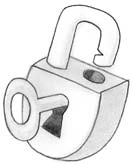The 1-2-3 Magic Workbook for Christian Parents: Effective Discipline for Children 2-12 (26 page)
Read The 1-2-3 Magic Workbook for Christian Parents: Effective Discipline for Children 2-12 Online
Authors: Thomas W. Phelan,Chris Webb
Tags: #Family & Relationships, #Parenting, #General

twenty minutes, but this procedure seems a little extreme.
Stay on your toes when a hungry little tot who didn’t finish her din-
ner puts the hit on you later for some dessert:
“I’m ready for my ice cream now.”
“You’ll have to finish your dinner first, honey.”
“It’s all cold.”
“We’ll just heat it in the microwave for a few seconds and it’ll
be good as new.”
“I didn’t like it anyway. I just want a little ice cream.”
“Now you know the rules, dear, you have to finish what’s on
your plate first. Remember, we didn’t give you that much in
the first place.”
“I never get anything!”
“What are you talking about—you never get anything?! That’s
enough of that! Either finish your dinner or stop bugging me!”
“I hate you!”
144 1-2-3 MAGIC
This interaction was an unfortunate waste of time and was also very
hard on this relationship. The conversation should have gone like this:
“I’m ready for my ice cream now.”
“You’ll have to finish your dinner first, honey.”
“It’s all cold.”
“We’ll just heat it in the microwave for a few seconds and it’ll
be good as new.”
“I didn’t like it anyway. I want just a little ice cream.”
“That’s 1.”
“Then I’ll go to bed starving!” (Walks away)
Mom did much better. There was no useless, little-adult talking, and
then mother ignored her daughter’s martyrdom.
The 3-out-of-4 Rule
Let’s return to the case of Picky Pete. Imagine that Peter’s parents sit down,
review the mealtime situation, and come up with a new plan. Mom and
Dad explain the new deal to their son: If Peter eats three out of four items
on his plate, the boy can have his dessert. The serving sizes will be smaller
and Peter has to at least taste the one thing he doesn’t choose to eat.
The first meal under the new regime goes well. Even though they are
a bit nervous, both parents avoid any anxious prompting. Peter finishes
his smaller portions of pork, mashed potatoes and peas. After tasting it,
he forgoes the salad. He gets ice cream for dessert.
After the mealtime overhaul, the first week passes without any
unpleasant incidents. Peter and his parents actually enjoy one another’s
company; the dinner table conversation is spirited and friendly.
“Pete, how was that movie you saw with your friend?”
“Oh, cool! You guys gotta see it!”
“You really think we’d like it at our advanced ages?”
“Oh, yeah! Let’s go—I’ll go see it again.”
“Well, if your mother’s willing, it might be possible.”
“Mom, you gotta go. It’s so neat! There’s this one part where...”

MEALTIMES 145
That’s the way meals should be. What if Peter and Alicia start
fighting? They would both be counted. In our original scene, it would go
something like this:
Peter: “But I don’t like any of it.”
Mom: “OK, if you don’t finish, there will be no dessert and nothing
else to eat before bed. Do you understand?”
Alicia (Peter’s sister): “I like what we’re having.”
Peter: “Oh, shut up!”
Mom: “That’s 1 for each of you.”
Some of you may wonder why Alicia should be counted. All she did
was say, “I like what we’re having.” The answer: It’s all in her timing.
The Divide-and-Conquer Routine
Many families seem to feel that there is a federal law that dictates that
every family eat supper together each and every night of the year. This
is the time, the experts claim, for “family togetherness” and for each
person to “share his or her day” with everyone else. Sometimes, however,
it seems that dinner simply becomes a time for everyone to share his
hostility
toward everyone else. Tempers as well
as appetites can be lost.
Key Concepts…
What can a parent do to improve this Who says you have to
situation? One solution, obviously, is not to eat dinner together
eat together every night. Though some people every single
consider this sacrilegious, it sure beats fighting night of the
year? Consider
all the time. Now you only have to fight every having some special
other night! Seriously, sometimes you might nights where each person
consider feeding the kids first or letting them eat eats wherever she wishes.
in front of the TV for once. Or, now and then, Or—better yet—have
some nights where one
let the kids eat wherever they want to, as long parent takes one child out
as they bring back their dishes. Then Mom and to eat. It’s different and
Dad can eat in the kitchen or have a peaceful it’s fun!
dinner together later.
Another idea is for each parent to periodically take one child out to
dinner as a kind of special occasion. This one-parent, one-child setup is

146 1-2-3 MAGIC
one that the kids love. It’s also one where sibling rivalry is not possible,
so the parent is much more relaxed and able to enjoy herself.
Think about dinnertime. Eating supper should be a pleasant experi-
ence. In fact, with most children eating is a natural and enjoyable function
that doesn’t require much parental intervention. With a little planning you
can enjoy your evenings a lot more.
Points to Remember...
How to make mealtimes more pleasant and more fun:
1. Small portions and a kitchen timer
2. The 3-out-of-4 Rule
3. The Divide-and-Conquer Routine

17
Homework and Practicing
Is there a potential Nobel Prize winner living in your house?
Homework civil wars can make school nights miserable for the
whole family. A typical scene involves junior sit ing at the kitchen
table after dinner staring out the window with a sour look on his face. The
boy’s favorite sister, who completed her homework years ago, sits in the
other room, smugly watching TV. Mom and dad check into the kitchen
every five or ten minutes to badger the reluctant scholar.
For some families, schoolwork bat les can go on for two, three or four hours
per night. People begin to dread the evening, relationships are strained
severely, and the child in question learns to hate schoolwork more and
more. There are no easy answers to the homework problem; children’s
needs vary depending upon their intelligence and the presence of handi-
caps such as learning disabilities and Attention Deficit Disorder. There are
ways, though, of making things more tolerable and more productive.
Routine Is Critical
First of all, the worst mistake you can make is to ask your child—just when
you happen to think about it—if he has homework. This is an example
of a spontaneous request, and your question is sure to provoke hostility.
147
148 1-2-3 MAGIC
Homework should be a daily
routine
—done at the same time and in the
same place as much as possible.
One of the best ways of setting things up is to have the child come
home, get a snack, goof around for about thirty to forty-five minutes and
then sit down in a quiet spot and try to finish his schoolwork before din-
ner. Then the whole evening is free for the youngster. The evening will
also then be free of homework hassles for you too. For many, but not all,
children, afternoon is preferable to evening for homework because the
child has more energy.
Don’t let your young student do academic work with the TV on. The
television is always out to get your attention. Believe it or not, however,
music from a CD or headset may be fine. For many young children and
teens, music provides consistent background noise, usually is not new to
the child and often tends to block out other household noises.
Natural Consequences
If you are having trouble with homework for the first time—say with
a fourth grader—consider trying the natural consequences
approach first. That means you do nothing: Keep quiet and see if the child and the
teacher can work things out. Too many parents get too anxious way too
soon about their children’s schoolwork, with the result that the grownup
prematurely takes charge and doesn’t give the youngster a chance to
learn—and exercise—true responsibility.
Let your daughter, for example, explain to
her
teacher why
her
work
was not completed. And when your daughter later complains to you about
how irritated her teacher was with her for not turning her homework in,
instead of saying, “I told you so,” say, “That must have been embarrassing
for you, but I’m sure you’ll do better tomorrow.” If this approach doesn’t
seem to be working after a few weeks, then switch to some of the other
alternatives listed below.
Natural consequences is obviously not the method to use, however,
if you have been having homework problems for years and years. With
chronic problems, you will need to take a closer look at why your child
is having such a hard time. Children with learning disabilities and atten-
tion deficit problems, for instance, not only need a well-thought-out daily
HOMEWORK AND PRACTICING 149
homework routine, these kids may also benefit from tutoring, treatment
or other academic accomodations.
Assignment Sheets
Assignment sheets or assignment notebooks can be extremely helpful for
kids who have homework troubles. Assignment notebooks tell you exactly
what work is due for each subject, which—among other benefits—helps
prevent lying about homework. Some schools have even instituted Inter-
net-based “Homework Hotlines,” where forgetful-but-fortunate kids can
log on after hours to find out what their assignments are.
Part of the idea of the assignment sheet, of course, is that after the
child does the work, the parents can check her productions against the
list of items to be done. If this is the procedure you are considering, you
should routinely include our next two homework procedures: the PNP
Method and the Rough Checkout. Failure to do so will result in unneces-
sary conflict and misery.
The PNP Method
Suppose your daughter has just completed her midweek spelling pretest.
There are ten words on the list, and she spelled nine correctly and mis-
spelled one. When she brings you her paper, your job, naturally, is to first
point out to her the word she spelled wrong. Right?
Wrong! PNP stands for “Positive-Negative-Positive.”
Whenever a
youngster brings any piece of schoolwork to you, the first thing out of your